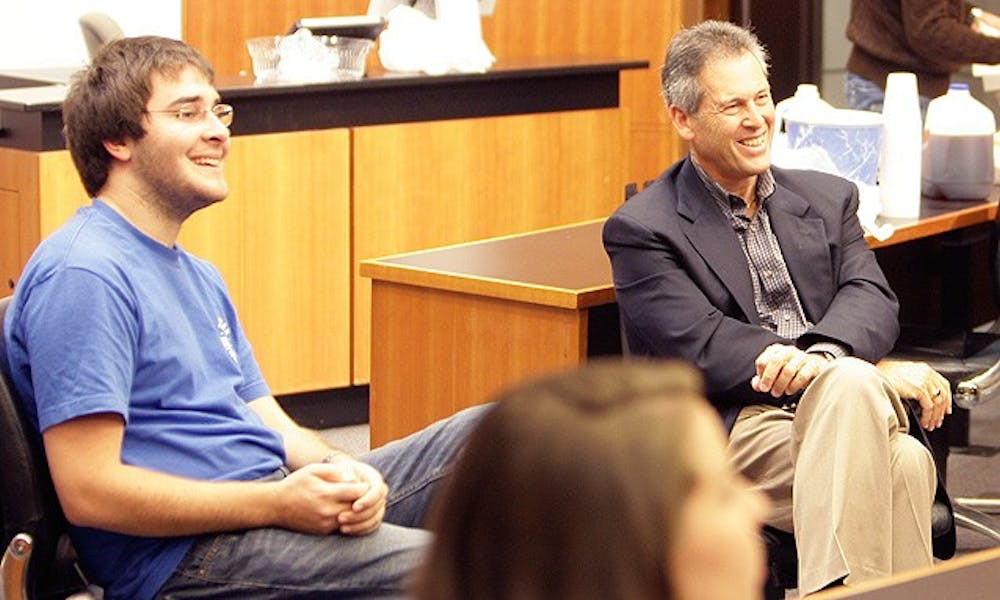Students should expect massive changes to Duke Dining—both in terms of venues and meal plans—but not until 2012.
Monday evening, the Duke University Student Dining Advisory Committee led the Duke Dining Fall open forum to obtain feedback and connect students with DUSDAC members and administrators. Topics of discussion focused on upcoming improvements, but administrators noted that costs still need to be controlled as Dining Services continues its attempt to cut its $2.2 million deficit.
Although only 11 non-DUSDAC students were at the forum, attendance increased significantly from the Spring forum, said senior Alex Klein, DUSDAC co-chair.
Klein said that attendance does not accurately reflect student interest in dining, however.
“In all of our conversations, Duke dining comes up a whole lot,” Klein said. “There are multiples avenues of getting your feedback in—maybe this was a bad time for people.”
A major theme of the forum was the future of dining at Duke. Vice President for Student Affairs Larry Moneta expressed displeasure with existing dining plans and suggested that students could expect a fairly significant change to occur for Fall 2012.
The most pertinent change for dining is the upcoming renovation of the West Union Building. Changes in both eateries and layout will accompany the renovation of the building into what Jim Wulforst, director of dining services, hopes will be a state-of-the-art facility.
“It hasn’t been updated since the ’50s—there are a lot of opportunities within that building,” said Moneta.
Finances continue to be a large problem for dining services. Moneta noted that a large part of the problem is due the general high quality of Duke food.
“We don’t serve crap—the lower the quality, the cheaper [the food] is,” he said. “We’re working against an inverse relationship.”
One student suggested an additional problem facing was high wages, which leave the $30 million program with little room to maneuver. Moreover, Duke Dining is still facing a deficit of $2.2 million. Moneta noted that Duke is committed to paying living wages to Dining employees and that these were not a problem, rather something that the University strongly endorses. Moneta declined the same student's request for more transparency in Dining, including giving students access to the budget, adding that releasing such information would create confusion in the student body.
Wulforst said that there is still much work to be done in balancing the wishes of students with financial concerns.
“How do we do both?” asked Wulforst. “How do we make sure the bills are paid without compromising the community experience?”
Franca Alphin, director of nutrition services at Student Health, also discussed nutrition on campus. She said it is unlikely that nutritional information will be made available at point of purchase, however the information will be made available online sometime in the near future. Alphin said that the display of nutrition information at point of purchase is detrimental to both efficiency and healthy eating. She expressed concern that students would misinterpret the components of a healthy diet, unnecessarily restricting their diets based on calories and grams of fat.
Alphin instead emphasized campaigns that encourage well-rounded eating, such as the current Balance Your Plate campaign, which encourages meals that include whole grains, fruits, vegetables, lean protein and healthy fats. Still Alphin noted that healthier dining options come with an increase in costs.
“As we strive to be a healthier campus, it’s going to me more expensive,” Alphin said.
In terms of programming, both a cooking demonstration center and extracurricular cooking classes are in the works. Those present also joked about creating a credit-bearing cooking class that would be listed under chemistry and count both as an Arts, Literature and Performance and Quantitative Studies requirement.
“It’s a [Cross-cultural Interaction] if it’s international food,” added Moneta.
This article has been updated to more accurately reflect conversation about Dining wages at Duke.
Get The Chronicle straight to your inbox
Signup for our weekly newsletter. Cancel at any time.

